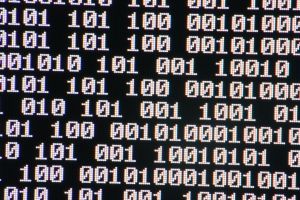What is 3D Fax (Binary Files over Facsimile and the Michelangelo Project)?
Last Update: August 9th, 2021
3D Fax is a term that has taken on two meanings – the first was a product introduced in the mid-1990s by InfoImaging, with the ability to transmit binary data over fax machines – a pre-internet method of sending complex data.
In recent years, the term “3D Fax” has evolved to mean the scanning and transmission of 3-dimensional data.
A project to record structures in their 3D format has been a project launched by Standford researchers at first labeled the “3D Fax Machine Project”, and now the “Digital Michelangelo Project.”
Table of Contents
- InfoImaging’s 3D Fax

- 3D Fax Machine Project and the Digital Michelangelo Project
- Additional Resources on 3D Faxing
- More Resources on the History of Fax
InfoImaging’s 3D Fax
3d Fax was a program created to allow binary files (such as computer programs) to transmit by fax machine.
Created by InfoImaging Technologies to run on Windows, the software would be used to encode the binary file onto a printed page. A fax machine would transmit that page where it could be decoded back into binary format and turned into a computer file.
While it was revolutionary at the time (allowing people to transmit files before computer modems became popular), there were some problems.
- The need to have 100% reliability from printing to faxing to decoding – if one part of the information does not transmit, then in most cases the file transmitted would be completely unreliable.
- The sender would require a printer and fax, and the receiver would require a fax and scanner. All equipment would need to be of high quality
- There was a limit of 50kb per page transmitted – anything further would require multiple sheets
The widespread adoption of the internet rendered InfoImaging’s 3D fax mostly obsolete.
3D Fax Machine Project and The Digital Michelangelo Project
Grown out of the interest for 3D recordings of real-life objects, researchers from Stanford University have embarked on a project to build a “3D Fax Machine” (since renamed The Digital Michelangelo Project) with the intention of recording Michelangelo’s works in 3D data.
The project has been able to record Michelangelo’s David and St Matthew both at 1/4mm resolution.
Since 2004 the project has been mostly stalled due to the need for extra funding.
The project’s archive of 3D models has samples of the work.
Additional Resources on 3D Faxing:
- thefreelibrary.com – InfoImaging Technologies Introduces 3D Faxing Technology…
- Wikipedia – Entry on 3D Faxing
- Stanford’s Project to Build a 3D Fax Machine
- Stanford’s Digital Michelangelo Project
More on the History of Fax:
- The History of Fax - From Alexander Bain's 1843 invention to today's internet based fax systems (and everything in between)
- Alexander Bain - Developed an Experimental Fax Machine between 1843 and 1846
- Arthur Korn - Developed Fax Machine for Transmitting Photographs
- Edouard Belin - Inventor of the Bélinographe
- Frederick Bakewell - Improved Bain's Facsimile Machine
- Giovanni Caselli - Inventor of the Pantelegraph. Sent images 800km across telegraph wires 9 years before Alexander Graham Bell's Telephone Patent
- Herbert E. Ives - Sent first color fax
- Richard H. Ranger - Invented first Transatlantic Radio Fax
- Rudolf Hell - Invented the Hellschreiber
- Shelford Bidwell - Research in the field of "Telephotography"
- Pantelegraph - An early fax invention used to transmit images over telegraph lines
- Fultograph - An early fax invention used to transmit images over radio waves"
- Telautograph - An early fax invention used to transmit signatures over long distances
- 3D Fax - A 1990s technique used to send computer code over a fax machine. Each page could hold about 50kb of information
- Radiofax - Still used today, a method for transmitting images over long distances through radio. Also known as HF Fax or Weatherfax